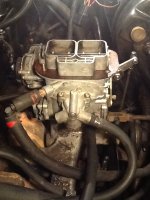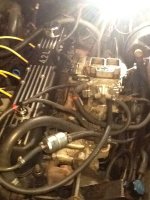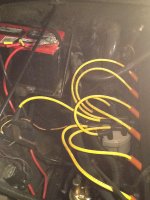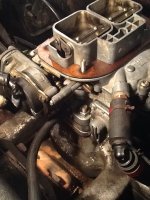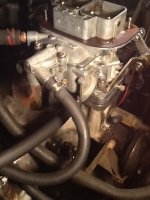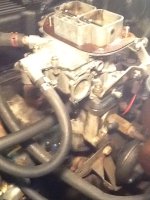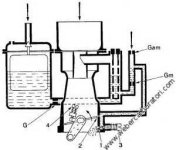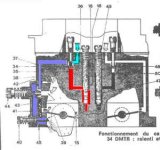With a properly tuned down draft carb (like the 32/36), you normally will not see fuel flow down the venturi’s during start up or low idle. They have their own low speed (idle) circuit that is below the throttle plate and can’t be seen without opening the linkage (throttle plates) at least 1/3 of the way. This explains why you saw fuel spraying while your wife was depressing the pedal, you activated all three circuits. Unfortunately, I’m at work and can’t scan diagrams in from the manual, but I did find the attached diagraph which illustrates the low speed circuit (however it is from a different model, but the principle is the same).
At this point, we know we are getting fuel up to the carb, have spark and that at least two of the circuits are supplying fuel. Have you adjusted the idle screws in any way? It sounds like the low speed circuit is closed. Regardless, using the proper sized screw driver, gently close (clockwise) the idle mixture screw until it bottoms out (this screw is on the base to the right facing the carb and it’s at an angle). Next you want to unscrew it 1 ½ turns. Then unscrew the idle speed screw (just above the idle mixture screw, perpendicular to it and has a spring around the screw shaft that touches the primary linkage) so it is not touching the linkage. Now screw that in 2 full turns. This is your starting base for a new install (or trouble shooting in our case).
If this does not at least cause some sort of fire up during starting, next we be removing the carb, disassembling it and looking for obstructions.
These links are helpful:
[*] store.cip1.com/.../graphics/00000001/XXX-WEBER-32-36DFEV.pdf
[*]
http://carburetion.net/pages/troubleshooting.aspx
[*]<img src="http://www.jeepz.com/forum/attachment.php?attachmentid=16508"/>
[*]<img src="http://www.jeepz.com/forum/attachment.php?attachmentid=16509"/>
[*]

